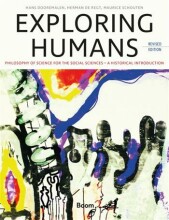Summary: Sociology Of The Arts Exploring Fine And Popular Forms | 9781118326527 | Victoria D Alexander
- This + 400k other summaries
- A unique study and practice tool
- Never study anything twice again
- Get the grades you hope for
- 100% sure, 100% understanding
Read the summary and the most important questions on Sociology of the Arts Exploring Fine and Popular Forms | 9781118326527 | Victoria D. Alexander
-
2 Reflection Approaches
-
What are you doing when you use reflection approaches within the sociology of arts?
- You look at art to learn about society.
- The reflection approach shares the belief that art mirrors society.
-
2.1 Roots of Reflection Approaches
-
An reflection approach can be found in Marxism. Can you explain which approach this was?
- Marxism posits that the culture and ideology of a society reflect the economic relations.
- Economic relations is the base of Marxism, with the distinction between workers (proletarians) and owners (capitalists).
-
Karl Marx poses: "With the change of the economic foundation the entire immense superstructure is more or less rapidly transformed."What does he mean with "superstructure?"
- The ideological forms.
- I.e., the combination of legal, political, religious, aesthetic, or philosophical forms.
- The ideological forms.
-
2.2 More Recent Reflection Analyses
This is a preview. There are 1 more flashcards available for chapter 2.2
Show more cards here -
For what purposes do recent sociologists use the reflection approach of art?
- They use art to understand the portrayals of social categories of interest to sociologists, as well as to understand social change.
- Social categories being things, such as the portrayals of:
- Gender, race, sexuality, social class, etc.
-
Name five examples of reflection approaches of art in sociological studies:
- Study of engravings of J.M.W. Turner.
- By Helsinger (1994).
- Study of the television series Friends.
- By Sandell (1998).
- Study of American children's books.
- By Weitzman et al. (1972).
- Study of advertisements of the 1960s and 1970s.
- By Goffman (1976).
- Study of popular arts, consisting of, American television commercials, prime-time television shows, and top-grossing Hollywood movies.
- By Entman and Rojecki (2001).
-
2.2.2 Friendship as Utopian Solution
-
What did the Reflection approach of Sandell (1998) of the popular television series Friends point out about society?
- The show has an "utopian promise" that alternative families (like a friends group) can substitute for both the failures of biological families and the failures of professional life in the contemporary world.
- The show does not champion normative heterosexuality and the nuclear family.
- The show reflects "whiteness," which does not reflect the actual demographic composition of New York City.
-
2.2.3 Gender Roles
-
What did the Reflection approach of Weitzman et al. (1972) of the analysis of children's books point out about society?
- Children's books reflect cultural values and stereotyped gender roles.
- Women and girls were largely invisible in children's books.
- Females are portrayed as less important in society than are males.
- Stories portrayed stereotyped gender roles.
- Picture books deny the existence of the discontented, the poor, the ethnic minorities, and the urban slum dwellers.
- Children's books reflect cultural values and stereotyped gender roles.
-
2.2.4 Understanding Rituals
-
What did the Reflection approach of Goffman (1976) of the analysis of advertisements point out about society?
- To make their meaning clear, advertisements point to familiar rituals from everyday live.
- Women are structurally subordinate to men, which can be seen through a myriad of displays common in advertisements.
- To make their meaning clear, advertisements point to familiar rituals from everyday live.
-
2.2.5 Race
This is a preview. There are 1 more flashcards available for chapter 2.2.5
Show more cards here -
What did the Reflection approach of Entman and Rojecki (2001) of the analysis of the popular arts point out about society?
- The media reflect the polarizing tendencies of racial prototypes.
- Over time the liminality of black people in American society has moved forward, but an era of complete acceptance of different racial groups and full integration in society has not yet been reached.
- The media reflect the polarizing tendencies of racial prototypes.
-
There is a clear distinction of prototypes from stereotypes.What is a prototype, in the context of sociology?
Prototypes are specific examplestypical of acategory .- Like a robin is an example
typical of thecategory birds .
- Higher grades + faster learning
- Never study anything twice
- 100% sure, 100% understanding
Topics related to Summary: Sociology Of The Arts Exploring Fine And Popular Forms
-
Shaping Approaches - Roots of Shaping Approaches
-
Shaping Approaches - Media Effects
-
Art world and Artistic Fields
-
Business and Industries - Industry Systems - Nobody Knows Principle
-
Business and Industries - Industry Systems - Decision Chains
-
Business and Industries - Industry Systems - Blockbusters
-
Business and Industries - Globalization and the Digital Revolution - Oligopoly and Global Media
-
Business and Industries - The Profit Motive
-
Nonprofits and Networks - Artistic Networks
-
Artists
-
Consumption Approaches - Reception Aesthetics
-
Sites and Experiences - Conceptions of the Audience
-
Identities - Subcultures, Tribes and Fans
-
The Art Itself - Representation
































